Easy Lemon Pasta Recipe

This lemon pasta is basically the adult equivalent of mac and cheese – comforting, ridiculously easy, and guaranteed to make you feel like you’ve got your culinary act together.
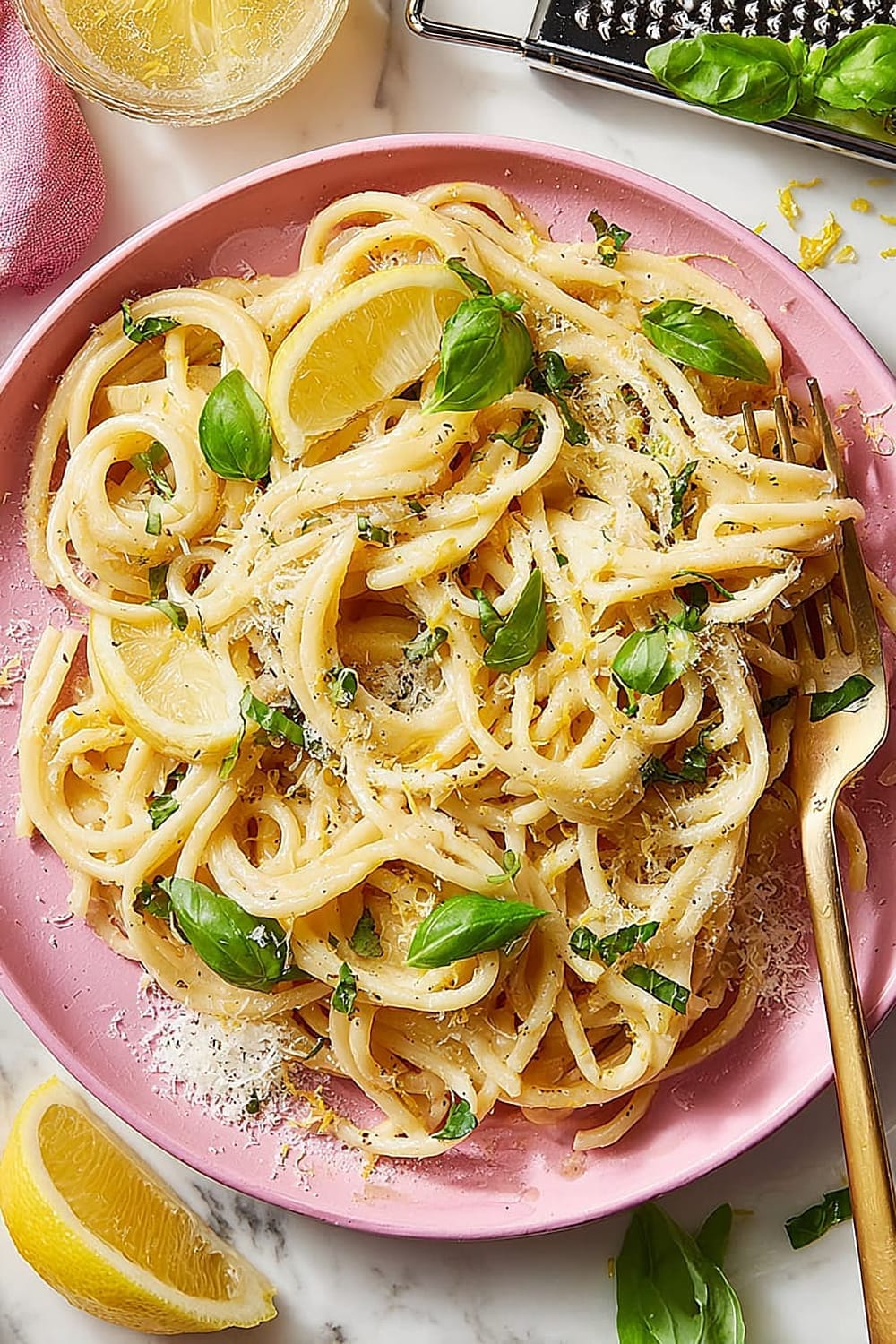
Five ingredients, twenty minutes, and zero chance of failure – this is the recipe that’ll save you when you need something impressive but your energy levels are running on empty.
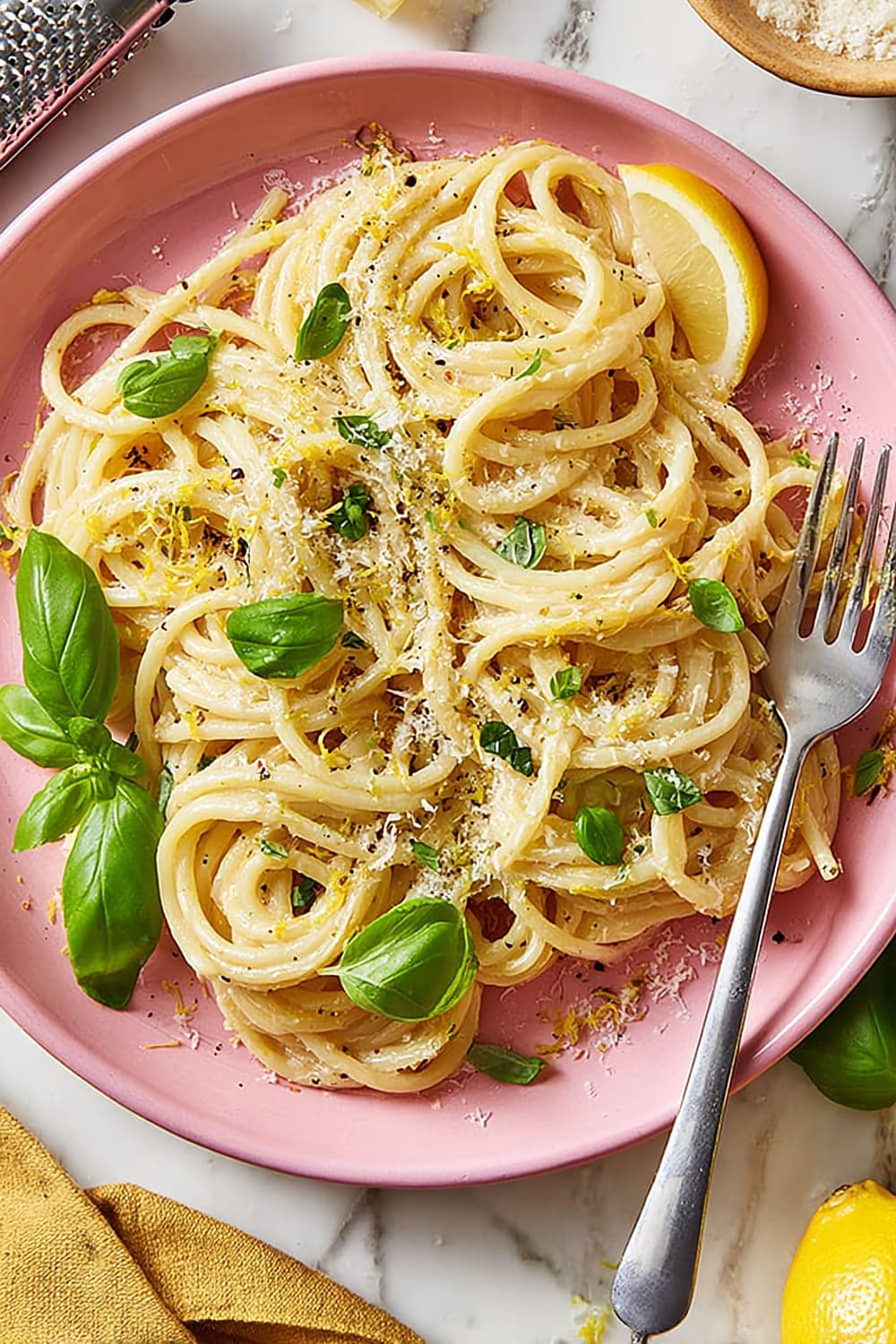
The magic happens when that starchy pasta water meets butter and Parmesan, creating a silky sauce that clings to every strand like it was meant to be there.
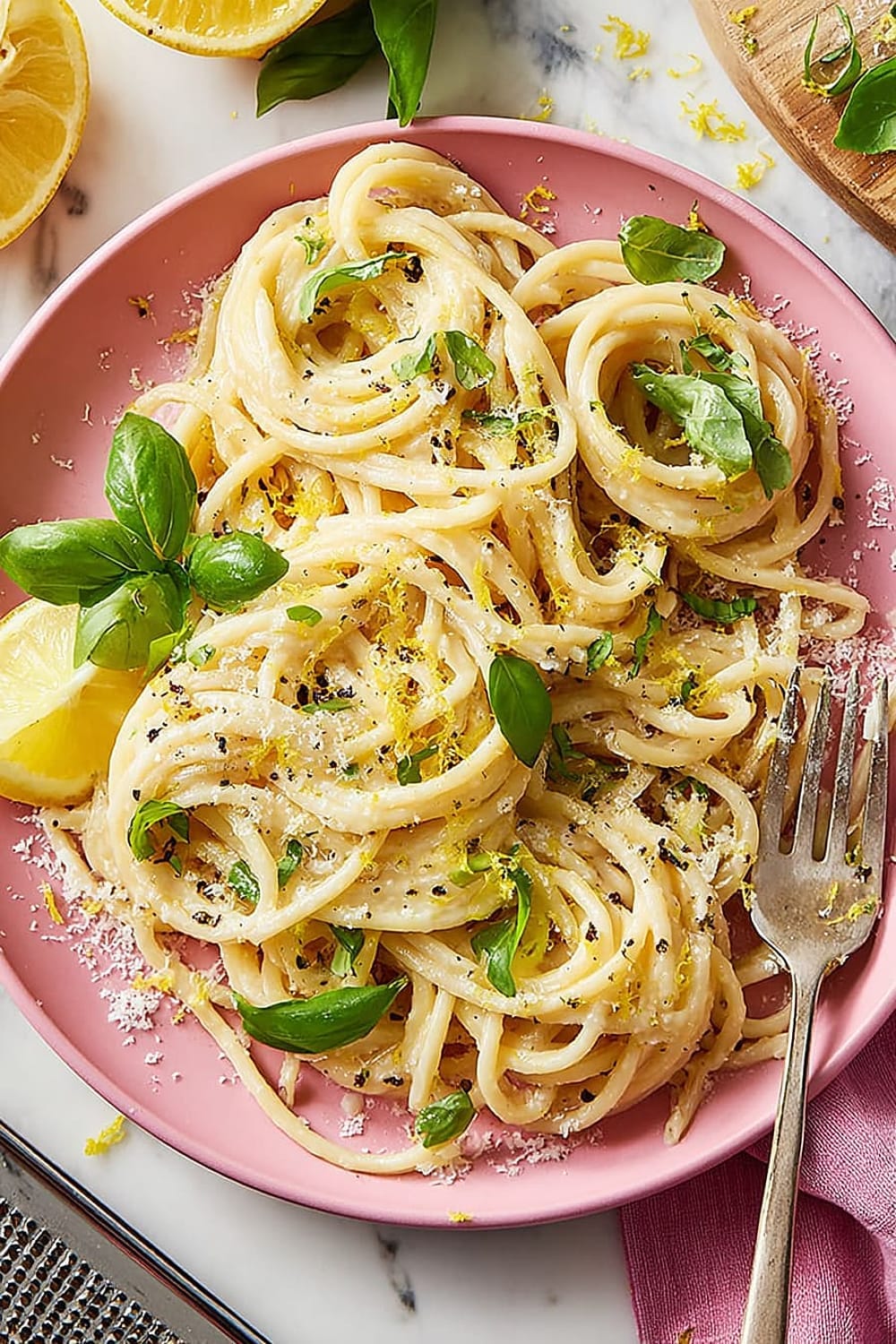
Fresh lemon zest transforms this simple dish into something that tastes like sunshine decided to have dinner at your place.
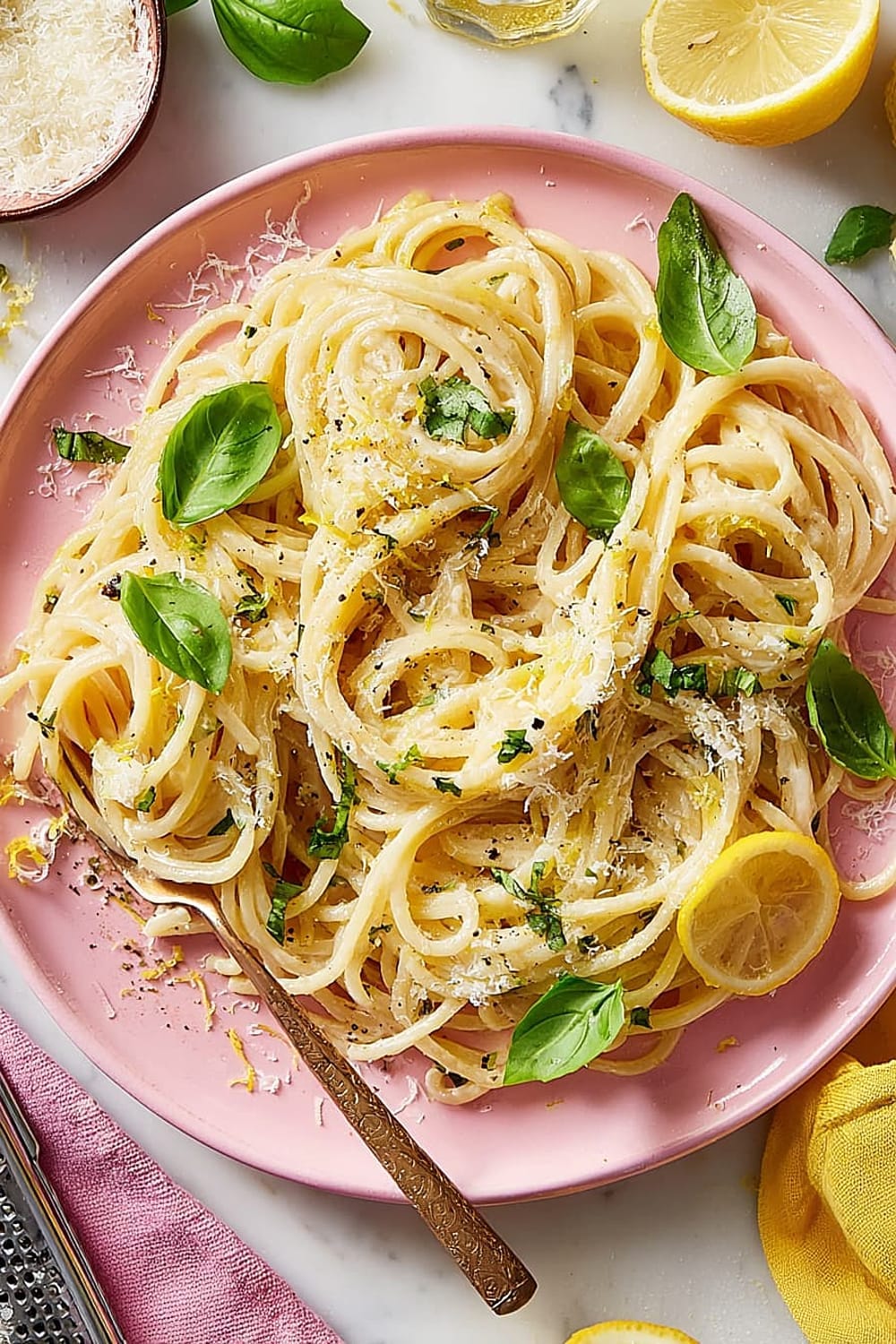
This is comfort food with a bright, sophisticated twist that works whether you’re feeding yourself on a Tuesday night or impressing weekend guests.

Warning: people will ask for the recipe, and you’ll have to decide whether to share your secret or let them think you’re just naturally gifted in the kitchen.

Ingredients
For the pasta
- 8 ounces spaghetti
- Large pot of salted water for cooking
For the lemon butter sauce
- 4 tablespoons unsalted butter, sliced into pats
- 2 tablespoons fresh lemon zest, plus more for garnish
- 2 garlic cloves, minced
- 1 tablespoon fresh lemon juice, plus more to taste
For finishing
- ½ cup freshly grated Parmesan cheese, plus more for serving
- Sea salt and freshly ground black pepper to taste
- Chopped fresh parsley or basil leaves, for garnish
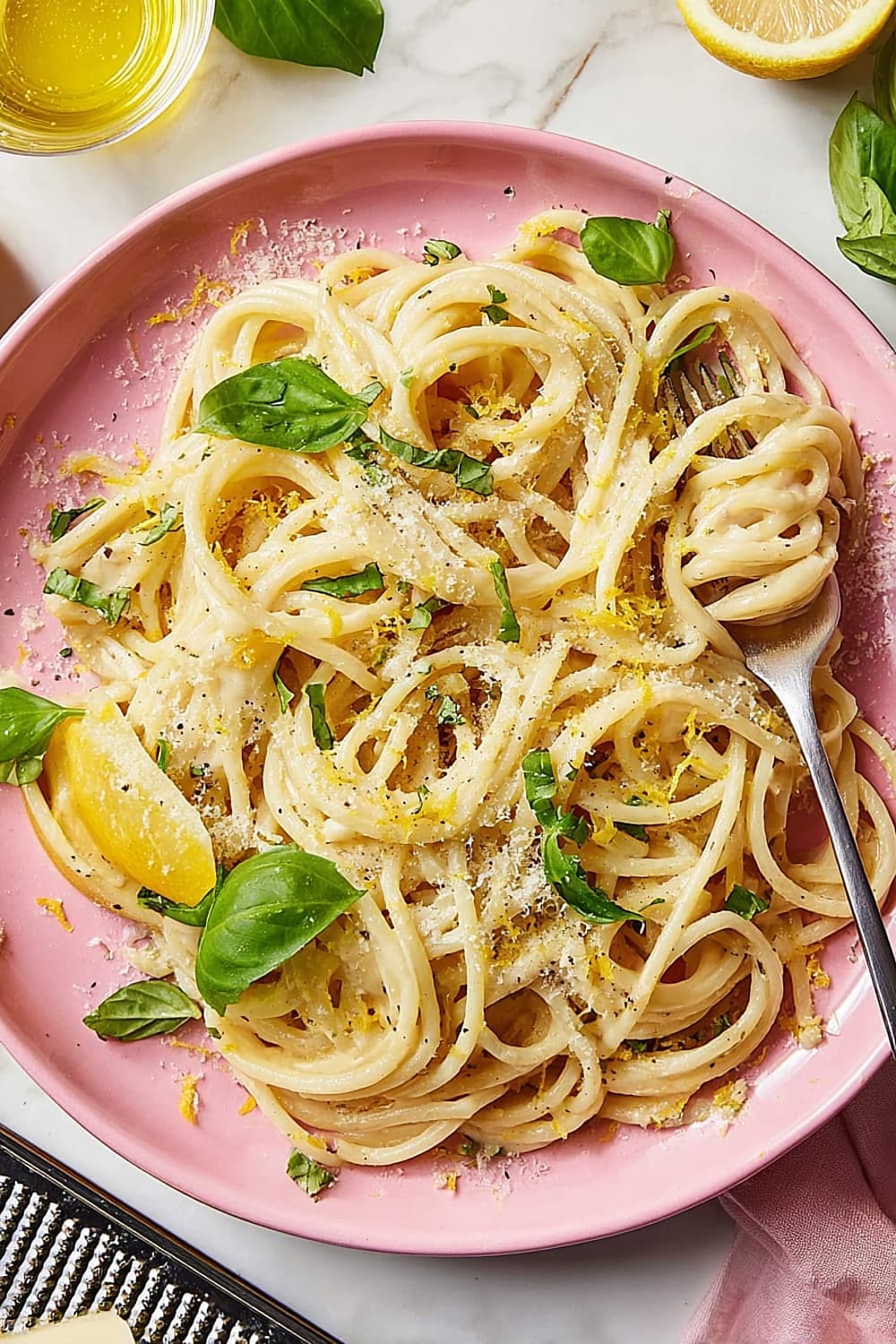
Instructions
Prepare the pasta
- 1 Bring a large pot of salted water to a rolling boil over high heat. The water should taste like mild seawater – this is your only chance to season the pasta itself.
- 2 Add the spaghetti and cook according to package directions until al dente, typically 8-10 minutes. In the final 2 minutes of cooking, reserve 1 cup of the starchy pasta cooking water using a heatproof measuring cup or ladle.
Create the sauce base
- 3 About 3-4 minutes before the pasta is ready, add the butter pats to a large skillet over medium heat. Let the butter melt completely and begin to foam – this indicates the water is cooking out and the butter is getting ready to brown slightly.
- 4 Reduce heat to low and immediately add the lemon zest and minced garlic. Cook, stirring constantly with a wooden spoon, for 1-2 minutes until fragrant but not browned. The garlic should sizzle gently without turning golden. Remove from heat if your pasta needs more time.
Combine and finish
- 5 When the pasta reaches al dente, use tongs to transfer it directly from the pot to the skillet with the butter mixture. Don’t drain it first – those few drops of pasta water help everything come together.
- 6 Add ½ cup of the reserved pasta water and return the skillet to low heat. Toss continuously with tongs until a glossy sauce begins to form and lightly coats each strand, about 1-2 minutes. The starch in the pasta water is creating an emulsion with the butter.
- 7 Add half the Parmesan cheese and toss vigorously to incorporate. Add the fresh lemon juice and remaining cheese, tossing again until the sauce is smooth and creamy. If the sauce becomes too thick or clumpy, add more pasta water 1 tablespoon at a time until it reaches the perfect consistency.
- 8 Remove from heat and season generously with salt and freshly ground black pepper. Taste and add more lemon juice if you want extra brightness – the flavor should be balanced between rich, salty, and bright.
- 9 Transfer to serving bowls and garnish with additional lemon zest, fresh herbs, and extra Parmesan cheese. Serve immediately while the sauce is still glossy and hot.
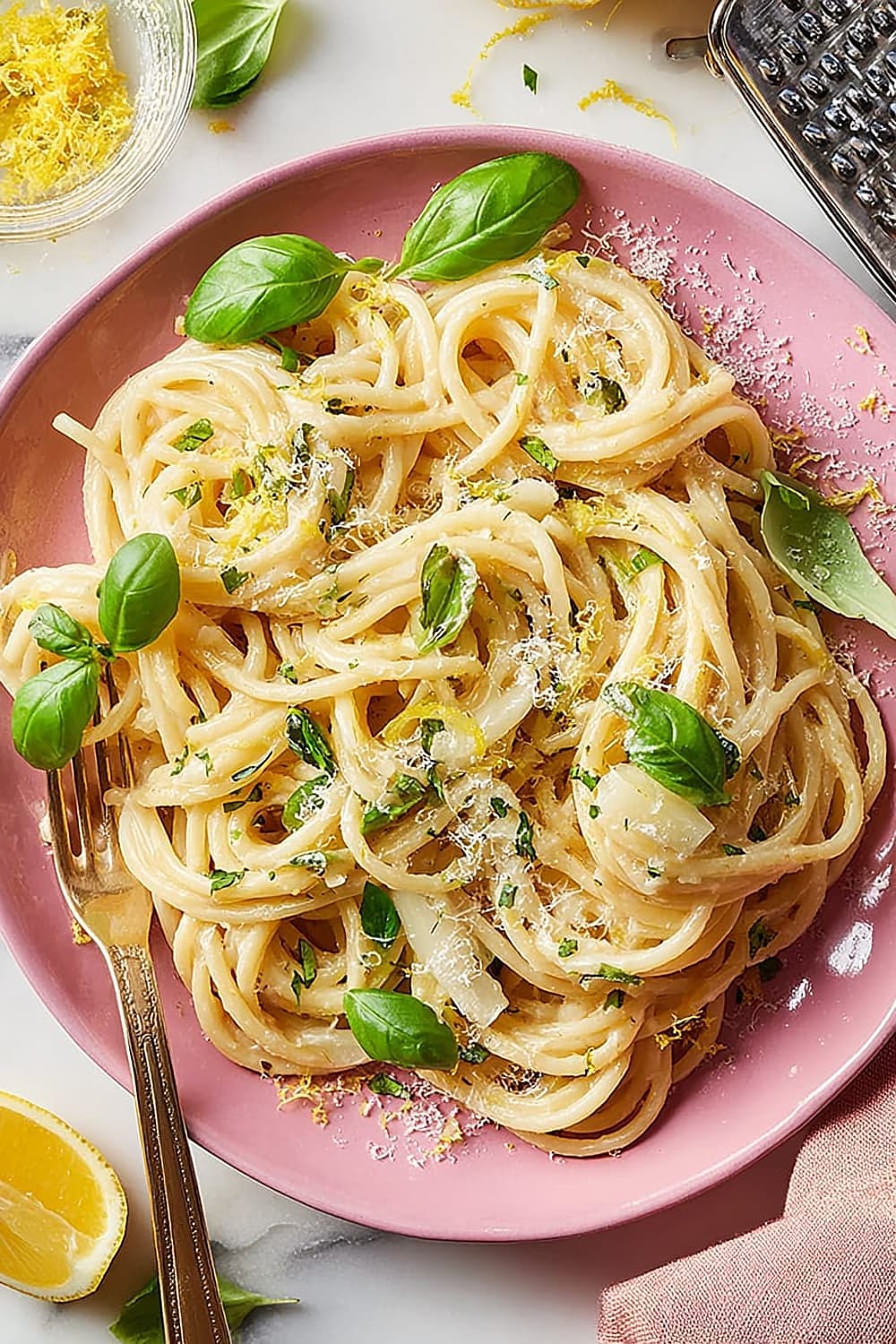
Recommended Equipment and Kitchen Tools
Essential Tools (for best results):
- Large pasta pot – A heavy-bottomed pot holds heat well and prevents sticking
- Large skillet – Cast iron skillet or heavy-bottomed pan distributes heat evenly for perfect sauce emulsion
- Tongs – Essential for transferring pasta and tossing without breaking strands
- Microplane grater – Creates fine, fluffy lemon zest that distributes evenly throughout the dish
Helpful Upgrades:
- Kitchen scale – Professional chefs measure pasta by weight for consistent results every time
- Fine-mesh strainer – Useful for reserving pasta water without losing any precious starch
- Wooden spoon – Won’t scratch your skillet and provides better control when stirring delicate garlic
Nice-to-Have Options:
- Pasta fork – Makes serving elegant and prevents sauce from sliding off noodles
- Citrus zester – Alternative to microplane for those who prefer slightly larger zest pieces
- Warming plates – Keeps the pasta at optimal temperature since this dish is best served immediately

Recipe Variations and Dietary Modifications
Gluten-Free Adaptation:
- Replace spaghetti with 8 ounces gluten-free pasta (rice-based works best for sauce adherence)
- Cook according to package directions, typically 1-2 minutes longer than wheat pasta
- Reserve extra pasta water as gluten-free pasta releases different starches
- Sauce may need additional pasta water to achieve proper consistency
Dairy-Free Modifications:
- Substitute butter with 4 tablespoons high-quality olive oil or vegan butter
- Replace Parmesan with ½ cup nutritional yeast plus 1 teaspoon salt for umami depth
- Add 1 tablespoon tahini for creaminess that mimics cheese
Protein Additions:
- 4 ounces grilled chicken breast, sliced thin and added in step 6
- ½ pound cooked shrimp, folded in during final tossing
- ¼ cup toasted pine nuts for vegetarian protein and texture
Flavor Variations:
- Mediterranean twist: Add 2 tablespoons capers and ¼ cup chopped fresh basil
- Herb garden version: Include 2 tablespoons each fresh thyme and oregano
- Spicy kick: Add ¼ teaspoon red pepper flakes with the garlic
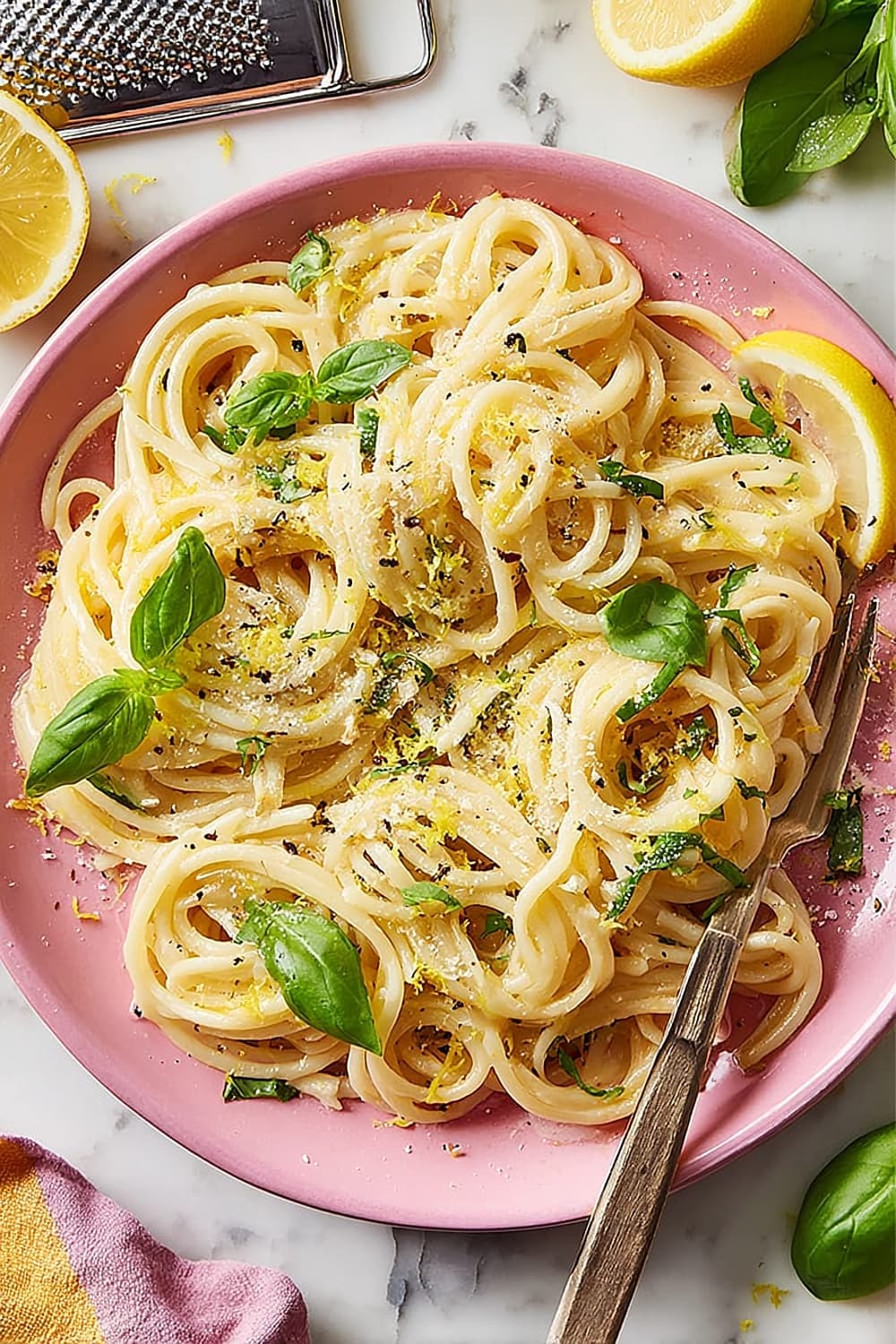
Nutritional Information and Health Benefits
Key Nutritional Highlights:
This recipe provides approximately 320 calories per serving when divided into four portions. The pasta contributes complex carbohydrates for sustained energy, while the Parmesan cheese adds 8 grams of protein and essential calcium. The butter provides vitamin A and helps with the absorption of fat-soluble vitamins from the lemon zest.
Health Benefits of Main Ingredients:
Fresh lemon zest contains powerful antioxidants called limonenes, which support liver detoxification and may have anti-inflammatory properties. The garlic provides allicin, a compound known for its immune-supporting and cardiovascular benefits. Parmesan cheese is naturally aged, making it easier to digest than many other dairy products, and it’s rich in calcium and phosphorus for bone health. The pasta water’s starch content helps create a silky sauce without needing cream, reducing overall saturated fat content.
Dietary Considerations:
This recipe contains gluten from wheat pasta and dairy from butter and cheese. It’s naturally vegetarian and can be made vegan with simple substitutions. The dish is relatively low in sodium when made with unsalted butter, allowing you to control salt levels. Each serving provides approximately 45 grams of carbohydrates, making it suitable for active individuals who need sustained energy.

Smart Swaps and Ingredient Substitutions
Common Substitutions:
- Spaghetti → Angel hair pasta (reduce cooking time by 2 minutes), linguine, or bucatini for different textures
- Fresh lemon zest → 1 tablespoon dried lemon peel (use half the amount as it’s more concentrated)
- Fresh garlic → ½ teaspoon garlic powder (add with lemon zest to prevent burning)
Budget-Friendly Swaps:
- Fresh Parmesan → Pre-grated Parmesan (use ¾ cup as it’s less dense) or aged Pecorino Romano
- Unsalted butter → Salted butter (reduce added salt accordingly)
- Fresh herbs → 1 teaspoon dried Italian seasoning mixed in during final toss
Pantry Emergency Substitutions:
- Fresh lemon juice → 2 teaspoons white wine vinegar plus 1 teaspoon sugar for acidity and brightness
- Lemon zest → 1 teaspoon lemon extract (add with pasta water to prevent overwhelming flavor)
Pro Tips for Substitutions:
- When using dried herbs instead of fresh, add them earlier in the cooking process to bloom their flavors
- Aged cheeses work better than young ones for sauce-making due to their lower moisture content
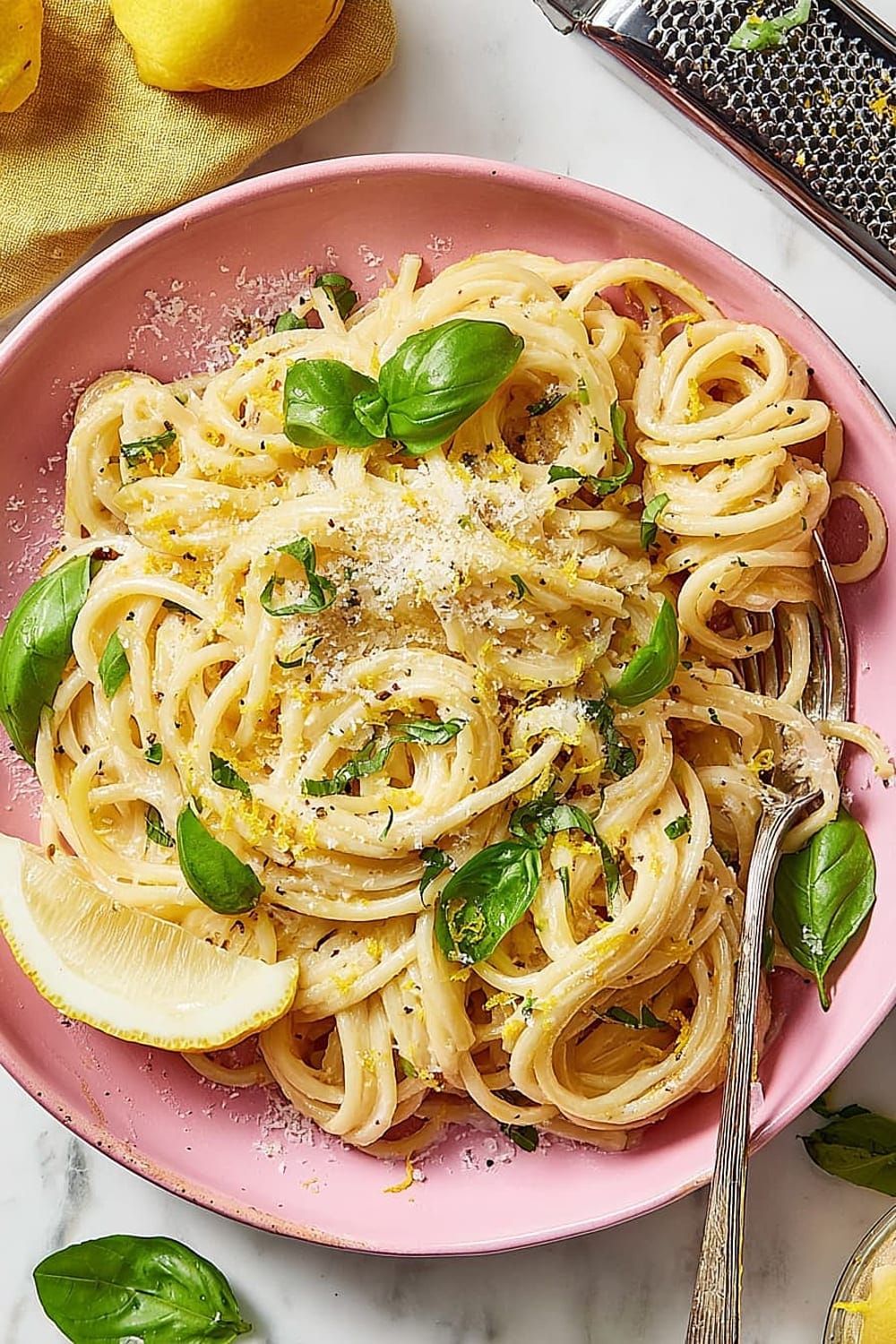
Make It Diabetes-Friendly
Carb Modifications:
- Replace regular spaghetti with 8 ounces shirataki noodles or zucchini noodles to reduce carbs from 45g to 8g per serving
- Use 4 ounces regular pasta mixed with 2 cups spiralized zucchini for a 50% carb reduction
- Try 6 ounces whole grain pasta for added fiber and slower glucose response
Portion & Timing Tips:
- Serve ¾ cup portions instead of full cups to reduce carb load to approximately 30g per serving
- Pair with 4 ounces grilled protein and a large mixed green salad to balance blood sugar response
- Add 2 tablespoons chopped walnuts for healthy fats that slow carbohydrate absorption
Enhanced Nutrition Strategies:
- Include 1 cup sautéed spinach or arugula folded in during final step for added fiber and nutrients
- Serve alongside roasted vegetables to increase meal volume without adding significant carbs
Total Carb Reduction: Modified versions can reduce carbohydrates from 45g to 15-30g per serving depending on pasta substitute chosen.

Perfect Pairing Suggestions
Beverage Pairings:
A crisp Pinot Grigio or Sauvignon Blanc complements the bright lemon flavors without competing with the delicate butter sauce. For non-alcoholic options, sparkling water with fresh lemon slices or a light herbal tea like chamomile enhances the meal’s fresh, clean finish. Beer lovers should opt for a light wheat beer or pilsner that won’t overpower the subtle garlic and cheese notes.
Side Dish Recommendations:
This pasta pairs beautifully with a simple arugula salad dressed with olive oil and balsamic vinegar – the peppery greens provide a nice contrast to the rich, creamy sauce. Roasted asparagus or broccolini add color and a slight bitter note that balances the dish’s richness. For a heartier meal, serve alongside grilled chicken breast or pan-seared salmon seasoned simply with herbs and lemon.
Complete Meal Ideas:
Start with bruschetta topped with fresh tomatoes and basil to continue the Italian theme, then follow the pasta with a light dessert like lemon sorbet or fresh berries with a drizzle of honey. For entertaining, this pasta works perfectly as a first course before grilled fish or roasted chicken, allowing the bright flavors to awaken the palate for the main event.

Pro Tips and Troubleshooting
Professional Techniques:
Always taste your pasta water – it should be well-salted but not overwhelming. The key to perfect sauce consistency is controlling the heat; too high and the sauce will break, too low and it won’t emulsify properly. Reserve more pasta water than you think you need – it’s your insurance policy for achieving the perfect creamy texture without adding cream.
Common Mistakes to Avoid:
Never rinse your pasta after cooking, as this removes the starch that helps create the sauce. Don’t let the garlic brown or it will become bitter and overpower the delicate lemon flavor. If your sauce appears oily instead of creamy, you’ve likely added the cheese too quickly or the heat was too high – add a splash of pasta water and toss vigorously off the heat to re-emulsify.
Storage and Reheating:
This pasta is best enjoyed immediately, but leftovers can be stored in the refrigerator for up to 2 days. Reheat gently in a skillet with a splash of pasta water or chicken broth to restore the sauce consistency. The dish can be made ahead through step 4, then finished when ready to serve.
Scaling Tips:
This recipe doubles easily, but use a larger skillet to accommodate more pasta. When serving a crowd, consider making multiple batches rather than one enormous batch to maintain proper sauce consistency and temperature control.

This lemon pasta proves that the best recipes are often the simplest ones – when you let quality ingredients shine with minimal interference, magic happens in the most effortless way possible.